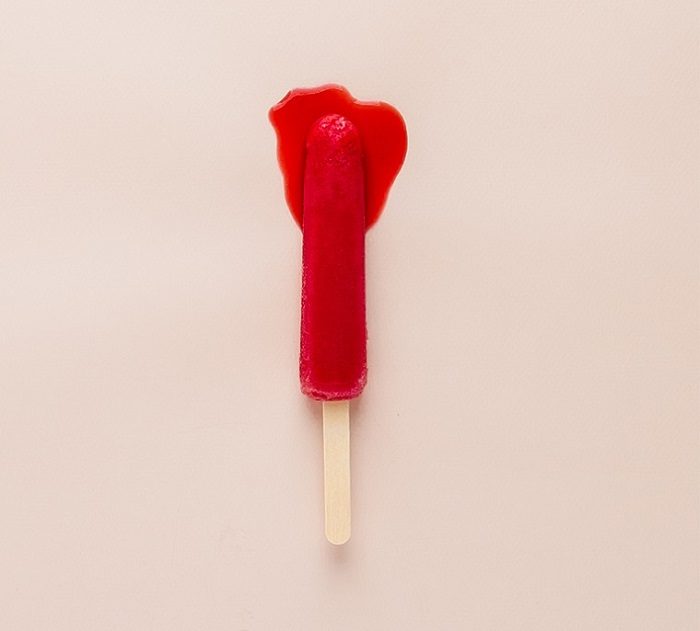Here I am: staring at the rows and clusters of brightly colored tampon boxes in the feminine hygiene aisle at the grocery store trying to figure out which cotton ball will cause the least amount of harm when I shove it into my vagina.
Pads were out of the question for a number of reasons. As an adult, I never again wanted to experience the squishing feeling of wearing a diaper—the crinkling between my legs—and rarely do I enjoy the idea of sitting on a microplastic bed soaked in my own hemoglobin. And let’s be honest, those adhesive strips and dainty little side wings are almost always a letdown.
Unfortunately, this decision is no longer about the volume of my flow, because then the choice would be easy: Tampax Triple-pack, so I am covered for the heavy days, light days, and all the days in between.
But now I must also decide:
Scented or unscented? Does that mean I’m shoving a cotton swab dipped in perfume up my vagina hole?
Feeling active? Maybe try Playtex sport. Tell me again who is doing splits and jumping around the tennis court on their period? Shouldn’t tampons just work regardless of my activity level?
Applicator? That can’t be good for the environment. Or no applicator? Eww.
Plastic? Certainly not good for the environment. Or cardboard? Weird, but doable.
Natural? Hmm catchy buzzword, I’m intrigued. Or organic? Organic? What the hell does that even mean—is there something edible inside?
My point of frazzled is reaching “Cathy” level. (If you don’t know what that is a reference to, google Cathy Guisewite Comic).
How does one decide what is important in life?
And when did buying a box of tampons get so effing complicated?
There was a point in my life when this wasn’t so difficult. I just thought about what I needed—Heavy flow? Super it is—then I bought it and moved on with my life, which I’m certainly going to hell for because that was before I knew that you weren’t supposed to flush the bloody cotton balls down the toilet. I thought the sign “do not flush feminine products” meant pad and tampon applicators—because obviously, you shouldn’t flush that sh*t. How would it fit in the pipes! But how was I supposed to know that these giant, white, absorbent cotton sperm were going to get stuck anywhere other than my vagina?
All that mattered to me was that I could easily flush away my bloody mess, leaving my trash can nice and free of things my dog might get into.
Attempting to be an environmentally conscious consumer is growing increasingly more difficult these days, with more choices than ever before, so a decision like this has also become increasingly more confusing.
I quickly learned not to trust packaging or marketing. Understanding the psychology of selling and playing on peoples’ values and emotions in order to increase consumption is a common practice, and just because something says it’s good/healthy/natural/organic doesn’t magically make a product environmentally friendly.
So at this point, I did what any good consumer would and whipped out my cell phone and typed:
Environmentally friendly tampons
In my pursuit of answers, this is what I learned:
Tampons and applicators are harmful to the environment, especially the applicators made of plastic, you know with those frightening sharp-toothed openings where the cotton pushes out like a wicked Chinese finger prison. Sure they slide in nice and smooth, but in some cases, they are contributing to beach closures. In fact, they are washing up so regularly at the Jersey Shore that they’ve become known as “Jersey beach whistles” because kids will find, pick up, and play with the plastic pieces, pretending they are whistles.
Change activists report picking up over 400 applicators over a two-month span of cleanup work along the beaches of Lake Ontario, and if they do make it to a landfill, they become one of 20 billion plastic applicators that can take up to 25 years to decompose. That’s if the applicator doesn’t make it to the incinerator where it will be melted into our atmosphere and oceans—releasing harmful chemicals and gases.
I began looking into tampon alternatives such as:
The menstrual cup: it is typically made of silicone, a polymer (synthetic and man-made) that will still end up sitting in a landfill someday, but it is less permeable and it is reported that they can last up to 10 years, though they still take a considerable amount of resources to produce. I’m just not sold on this one right now.
Period panties and re-usable cloth for menstruation might be nice, as one woman describes here, but for someone like me who is traveling all the time, not knowing when I’ll have access to a washing machine, these just don’t seem to be a good alternative.
To be perfectly honest, I’m not sold on anything. The grocery store doesn’t have these alternatives, so I would have to special order them. So while there are alternatives, more than 88 percent of the tampon market is made up of tampons with plastic applicators, and as a consumer, grocery store tampons are my best option right now.
But that was not the sole purpose of this journey. It might not matter what tampons I choose or don’t, and it’s not about “rightness,” it’s about understanding that the world is complicated but we don’t need to ear-muff or blindfold our way through it. We can ask questions, start conversations, and offer suggestions, which is how, as consumers, we can encourage change. I believe it is within our rights to ask for convenience and environmentally friendly products.
I will admit that entering into the world of mindful consumerism was a bit stressful at first, but having the ability to make educated and informed decisions about what my money is supporting, and the resources used to produce and dispose of the products I consume, feels empowering.
Am I always going to make the “right” decision? No, of course not—things change and so does what we believe, what we know, and what we are told. Instead of feeling stressed, I am enjoying the process and approaching how to dispose of my flow with a sense of curiosity.
~












Read 13 comments and reply